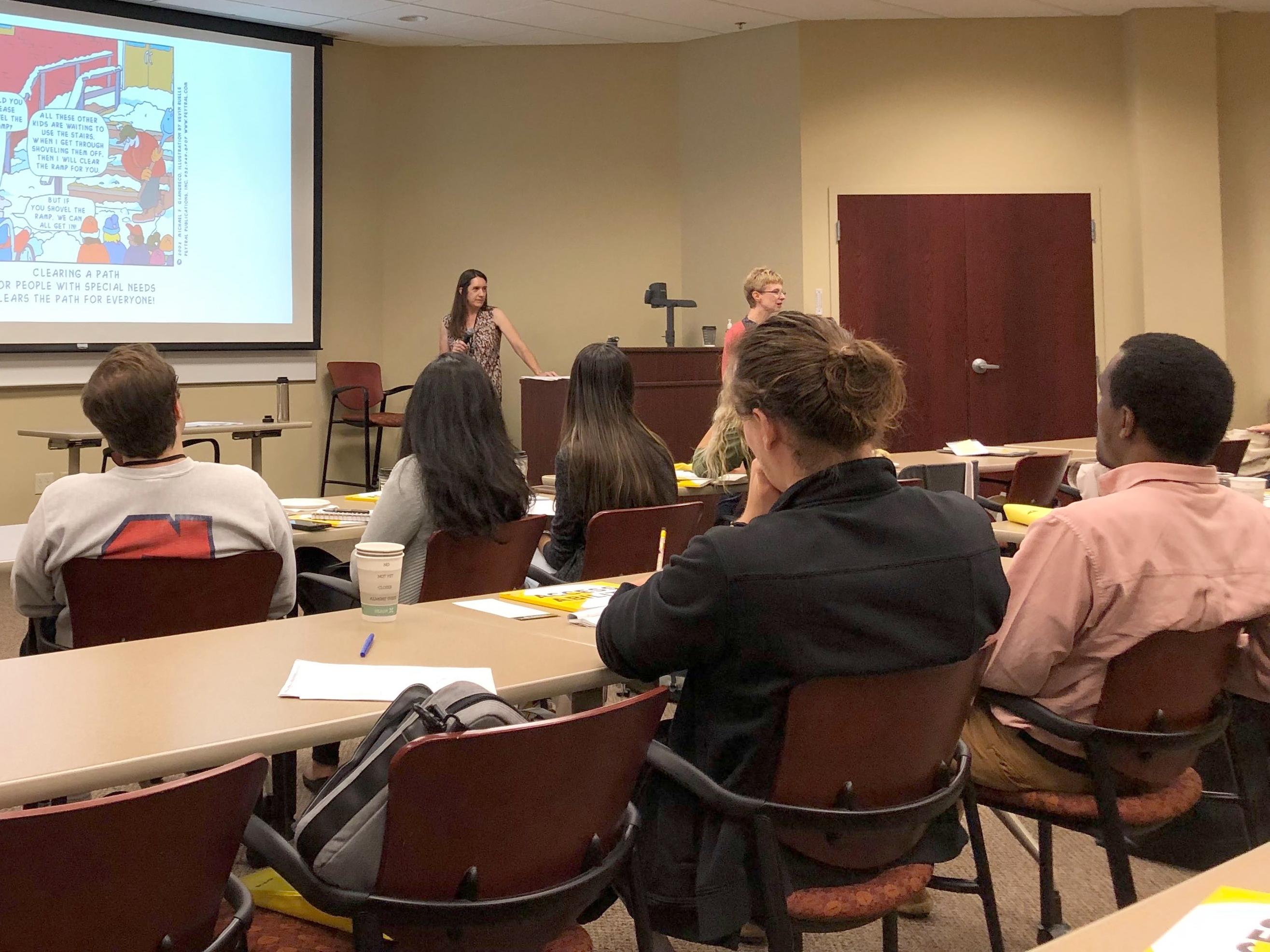Promoting accessibility -- Kate Percival and Rebecca Mushtare (presenting, from left) lead an on-campus digital accessibility workshop in this file photo. Oswego's efforts earned praise and highlights from SUNY when the system recently dedicated a week to promoting greater access for learning.
Oswego’s many avenues toward digital accessibility were prominently featured as part of SUNY Accessibility Week, and received prominent praise from the system.
“Oswego’s accessibility website has a ton of resources,” Nazely Kurkjian, coordinator of disability, diversity and nontraditional students services for the SUNY system said in the series’ closing session on May 26. “Kate Percival and Rebecca Mushtare have created so many different nice and succinct videos on how to achieve accessibility in Word and PDFs and all these other things. I really like their campus website for accessibility.”
Percival and Mushtare were among the presenters for the system-wide virtual conference. Percival presented two May 20 sessions -- “Improving PDF Accessibility,” teaming with Kurkjian, and “Creating a More Accessible PowerPoint” -- while Mushtare contributed “What’s your accessibility plan for your own teaching?” on May 26.
The presentations showcased “demonstrations of simple techniques and principles that can be used to help improve accessibility for digital documents,” said Percival, digital accessibility analyst for SUNY Oswego. “We also explained how improving digital accessibility (or lack thereof) impacts those who use assistive technology, such as screen readers.”
Percival added that SUNY continues to be “extremely supportive” of the college’s accessibility work, as Oswego’s proactive approach has positioned it among the leaders in the field among SUNY campuses. “I have collaborated with colleagues from both the local and state levels to help plan conferences and presentations that were well-attended and very well-received,” Percival said.
Supporting students
The session on creating an accessibility plan “forced me to think through what to prioritize initially and what could be cycled in as the class evolves over the semester and in future semesters,” said Mushtare, an art faculty member and associate director of the college’s Center for Excellence in Learning and Teaching.
“For me, that means taking the time and effort to make sure each student’s initial interactions with the course, with their peers, and with me as the instructor is accessible, supportive and inclusive,” Mushtare explained. All invitations and communications should be clear and fully accessible to ensure students start the course with the correct information and preparation, she said.
“Likewise, making sure the course materials, like texts and assignments, are readily available, accessible, and affordable,” Mushtare added. “The second piece of the presentation focused on a few inclusive pedagogy principles: building in flexibility, building engagement and providing support. There are big and small ways we can implement those principles to include all of our students. We certainly can’t do everything, but we can each take steps to make our classes more inclusive.”
Robust resources
Mushtare praised “a very committed group of practitioners on our campus who have put together really robust resources (most of which are housed on our accessibility website) and trainings. The team includes administrators, faculty and staff who all work together very collaboratively, which is why we have been so successful.”
She also noted the Faculty Accessibility Fellows program helps the college know what faculty need, what faculty might struggle with and that faculty are very committed to providing inclusive learning environments.
“I’ve learned and grown a lot through my involvement with this team,” Mushtare noted. “Not all SUNY schools have this level of collaboration. Our ability to extend our knowledge to the SUNY system has connected all of us to colleagues at other schools that continue to push our work forward.”
“Accessibility is extremely important on many levels, for many people,” Percival said, as “1 in 4 people have a disability of some kind, and students are not required to disclose that information. So, it is entirely possible, in fact highly likely, that faculty are unknowingly teaching at least one student who has a disability.”
The switch to remote teaching introduced new factors, such as students potentially not having high-speed internet or any internet access, having to share internet access with multiple family members, financial or mental health stresses, studying with a baby or young children around and having difficulty finding a quiet environment in their living arrangements.
“Accessibility helps those with disabilities, but it also helps those whose environments have changed,” Percival noted. “Accessible teaching practices are a proactive way to help change the learning environment and improve the learning experience for all students, regardless of their situation.”
“Committing to accessibility commits to acknowledging members of our community (students, faculty and staff) who have been invisible,” Mushtare added. “Access is about equity. We all benefit from the ability to access digital content and experiences from a wide range of devices/technologies in a wide range of contexts.”




